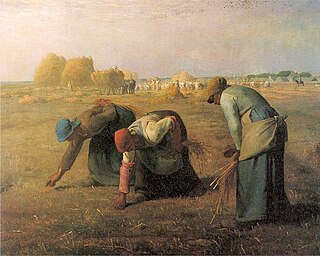
Naïve art is usually defined as visual art that is created by a person who lacks the formal education and training that a professional artist undergoes. When this aesthetic is emulated by a trained artist, the result is sometimes called primitivism, pseudo-naïve art, or faux naïve art.

The Barbizon school of painters were part of an art movement towards Realism in art, which arose in the context of the dominant Romantic Movement of the time. The Barbizon school was active roughly from 1830 through 1870. It takes its name from the village of Barbizon, France, near the Forest of Fontainebleau, where many of the artists gathered. Some of the most prominent features of this school are its tonal qualities, color, loose brushwork, and softness of form.

Mihály Munkácsy was a Hungarian painter. He earned international reputation with his genre pictures and large-scale biblical paintings.

Ján Kupecký or Jan Kupecký was a Czech and Slovak portrait painter during the baroque. He was active in Hungary, Slovakia, Vienna and Nürnberg. Bernhard Vogel produced a large number of engravings after Kupecký's paintings.

Isidor Kaufmann was an Austro-Hungarian painter of Jewish themes. Having devoted his career to genre painting, he traveled throughout Eastern Europe in search of scenes of Jewish, often Hasidic life.

Tivadar Csontváry Kosztka was a Hungarian painter who was part of the avant-garde movement of the early twentieth century. Working mostly in Budapest, he was one of the first Hungarian painters to become known in Europe. On 15 December 2006 the Kieselbach Gallery in Budapest sold an auction the most expensive Csontváry painting so far. The Rendezvous (1902) was bought by an anonymous client for more than one million EUR.

Gyula Basch, was a Hungarian painter.

Zygmunt Ajdukiewicz was a Polish realist painter of the late 19th century specializing in portraits, genre and historical painting. Ajdukiewicz, born and raised in the Austrian sector of Partitioned Poland, settled in the imperial capital upon the completion of his studies, but maintained a close connection with his homeland. While in Vienna, he illustrated the epic novel The Deluge (Potop) by Polish Nobel Prize-winning novelist Henryk Sienkiewicz.

Bábonymegyer is a village in Somogy County, Hungary. Until 1927 it was two separate villages, Nagybábony and Koppánymegyer.

Mór Adler was a Hungarian painter.

Károly Ferenczy was a Hungarian painter and leading member of the Nagybánya artists' colony.

János Thorma was a Hungarian painter. A representative figure of the Nagybánya artists' colony, which started in 1896, in Nagybánya, Austria-Hungary, He moved through different styles, shifted from the naturalism that was the aesthetic of the colony, to historical subjects, to romantic realism and to a Post-Impressionism style. His work is held by the Hungarian National Gallery, the Thorma János Múzeum, regional museums and private collectors.

Jakob Bogdani, whose names are sometimes spelt Jacob and Bogdány, was a Hungarian and British artist well known for his still life and exotic bird paintings.
The Arrival of the Hungarians is a large cyclorama – a circular panoramic painting – by Hungarian painter Árpád Feszty and his assistants, depicting the beginning of the Hungarian conquest of the Carpathian Basin in 895.

Lajos Tihanyi was a Hungarian painter and lithographer who achieved international renown working outside his country, primarily in Paris, France. After emigrating in 1919, he never returned to Hungary, even on a visit.

Alajos Györgyi Giergl was a Hungarian painter. He is notable for his portraits and paintings in the Romanticism style.
Jenő Medveczky was a Hungarian painter significant to Hungarian neo-classic painting.
Oszkár Nagy was a Hungarian painter. Representative for the school of painting from Baia Mare, Romania.















